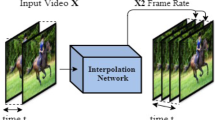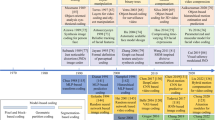Abstract
Digital video sequences in uncompressed form require huge storage and high transmission bandwidth for multimedia communication. The increasing number of Video over Wireless (VoW) services is creating greater thrust for higher coding efficiency for digital video signals. Efficient coding and transmission control techniques are required to meet the needs of Quality of Service (QoS). H.264/MPEG4-advanced video coding (AVC) video enCOder/DECoder (CODEC) is the latest coding and compression standard from the International Telecommunications Union-Telecommunication (ITU-T). This standard is currently dominating the field by offering a flexible architecture and compression gain for video coding. Due to its high compression efficiency with low compression delay, it is used in many real time VoW transmission applications. Modern wireless networks provide many different means to adapt QoS like low end-to-end delay, efficient bandwidth-utilization and lower bit-rate. This paper presents a design of integrated CODEC scheme with relatively lower bit-rate and improved edge peak signal-to-noise ratio (EPSNR). Several important factors of video sequence are analyzed for achieving lower bit-rate. A new scheme is proposed at Application (APP) layer for video compression, called as Enhanced Intra Prediction (EnIP). This algorithm uses picture structure without B-pictures for real time VoW application. The proposed algorithm is implemented on TMS320DM6437; a multimedia processor, using Digital Video Development Platform (DVDP). The superior performance of the proposed EnIP algorithm is validated by experimental results. It shows that the implementation of EnIP using digital multimedia processor lowers the bit-rate and improves EPSNR significantly.














Similar content being viewed by others
Abbreviations
- 2D:
-
2 Dimensional
- APP:
-
Application layer
- AVC:
-
Advanced video coding
- CODEC:
-
enCOder/DECoder
- CCStudio:
-
Code Composer Studio
- DVDP:
-
Digital Video Development Platform
- EPSNR:
-
Edge Peak Signal-to-Noise Ratio
- EnIP:
-
Enhanced Intra Prediction
- EVM:
-
Evaluation Module
- IDR:
-
Instantaneous Decoding Refresh
- ITU-T:
-
International Telecommunications Union-Telecommunication
- Kbps:
-
Kilobytes per second
- MPEG-4:
-
Moving Picture Experts Groups-4
- \(\hbox {MSE}_\mathrm{edge}\) :
-
Edge Mean Squared Error
- PCI:
-
Peripheral Component Interconnect
- PSNR:
-
Peak Signal-to-Noise Ratio
- QCIF:
-
Quarter Common Intermediate Format
- QoS:
-
Quality of Service
- RDO:
-
Rate distortion optimization
- RR:
-
Reduced-reference
- SI:
-
Switching I
- SP:
-
Switching P
- TI:
-
Texas Instruments
- VLC:
-
Variable-length coding
- VoW:
-
Video over Wireless
References
Prasad, R., & Ruggieri, M. (2003). Technology trends in wireless communications. London: Artech House Universal Personal Communications.
Korhonnen, J. (2003). Introduction to 3G mobile communications (2nd ed.). Bostan: Artech House.
Bovik, A. (2000). Handbook of image and video processing. USA: Academic Press.
Wiegand, T., Sullivan, G. J., Bjontegaard, G., & Luthra, A. (2003). Overview of the H.264/AVC video coding standard. IEEE Transactions on Circuits and Systems for Video Technology, 13(7), 560–576. doi:10.1109/TCSVT.2003.815165.
Mizosoe, H., Okada, M., Komi, H., Sasamoto, M., & Hatori, Y. (2012). Very low-delay H.264 codec for consumer applications. In 2012 IEEE conference on consumer electronics (ICCE), pp. 65–66, doi:10.1109/ICCE.2012.6161739.
Objective perceptual visual quality measurement techniques for broadcasting applications using low definition television in the presence of the reduced bandwidth reference (2010). ITU-R, Recommendation ITU-R BT.1867.
Marpe, D., Wiegand, T., & Sullivan, G. J. (2006). The H.264/MPEG4 advanced video codin standard and its applications. IEEE Communications Magazine, 44(8), 134–143. doi:10.1109/MCOM.2006.1678121.
Lin, H.-C., Wang, Y.-J., Cheng, K.-T., Yeh, S.-Y., et al. (2006). Algorithms and DSP implementation of H.264/AVC. In Asia and South Pacific conference on design automation (Vol. 8, pp. 24–27). Taiwan. doi:10.1109/ASPDAC.2006.1594775.
Rungta, S., & Tripathi, N. (2009). Enhanced mode selection algorithm for H.264 encoder for application in low computational power devices. International Journal of Computer Science and Information, Security, 4(1,2), 251–255.
Sahin, E., & Hamzaoglu, I. (2007). An efficient hardware architecture for H.264 intra prediction algorithm. In Design, automation and test in Europe conference and exhibition, 2007, DATE’07. Turkey. (pp. 1–6). doi:10.1109/DATE.2007.364588.
Kao, C.-C., Lai, Y.-T., & Tseng, C.-F. (2012). Laplacian-based H.264 intra-prediction mode decision. In 7th international ICST conference on communications and networking in China (CHINACOM), China, (pp. 638–641). doi:10.1109/ChinaCom.6417561.
Han, K.-H., & Lee, Y.-L. (2005). Fast macroblock mode determination to reduce H.264 complexity. IEICE Transaction Fundamentals, E88–A(3), 800–804.
Lee, J., & Jeon, B. (2004). Fast mode decision for H.264. In 2004 IEEE international conference on multimedia and Expo, ICME’04 (Vol. 2, pp. 1131–1134). doi:10.1109/ICME.2004.1394416.
Meng, B., Au, O. C., Wong, C.-W., & Lam, H.-K. (2003). Efficient intra-prediction algorithm in H.264. In Proceedings. 2003 international conference on image processing, 2003. ICIP 2003, 3(III) (pp. 837–840). doi:10.1109/ICIP.2003.1247375.
Pan, F., et al. (2003). Fast mode decision algorithm for JVT intra-prediction. JVT-G013, Pattaya, Thailand, 7th JVT Meeting March 2003.
Yong-dong, Z., Feng, D., & Shou-xun, L. (2004). Fast \(4\times 4\) intra-prediction mode selection for H.264. In 2004 IEEE international conference on multimedia and expo, 2004. ICME’04. 2 (pp. 1151–1154). doi: 10.1109/ICME.2004.1394421.
Cheng, C.-C., & Chang, T.-S. (2005). Fast three step intra prediction algorithm for \(4\times 4\) blocks in H.264. In IEEE international symposium on circuits and systems, 2005. ISCAS 2005 (Vol. 2, pp. 1509–1512). doi:10.1109/ISCAS.2005.1464886.
Hwang, M.-C., Cho, J.-K., Kim, J.-H., Ko, S.-J. (2005). A fast intra prediction mode decision algorithm based on temporal correlation for H.264. International technical conference on circuits systems, comuters and communications (pp. 1573–1574). Jeiu.
Zheng, J. Xu, C., & Guo, J. (2012). An effective approach for hardware Design of Intra Prediction in H.264 AVC. International conference on anti-counterfeiting, security and identification (ASID) (pp. 1–4). doi:10.1109/ICASID.2012.6325313.
Liu, S., & Lei, S. (2012). Video prediction block structure and the emerging high efficiency video coding standard. In Signal and information processing association annual summit and conference (APSIPA ASC), 2012 Asia-Pacific, (Vol. 1, no. 4, pp. 3–6).
Texas Instruments Incorporated. (2007). Texas Instruments. [Online]. http://www.ti.com/dm6437dvdp
Elecard company. (2012). www.elecard.com. [Online]. http://www.elecard.com/en/products/professional/analysis/streameye.html.
Author information
Authors and Affiliations
Corresponding author
Rights and permissions
About this article
Cite this article
Koli, S.M., Purandare, R.G., Kshirsagar, S.P. et al. Improved Compression Performance of H.264/MPEG4-AVC for Digital Video Using DVDP. Wireless Pers Commun 77, 1659–1675 (2014). https://doi.org/10.1007/s11277-014-1600-y
Published:
Issue Date:
DOI: https://doi.org/10.1007/s11277-014-1600-y




